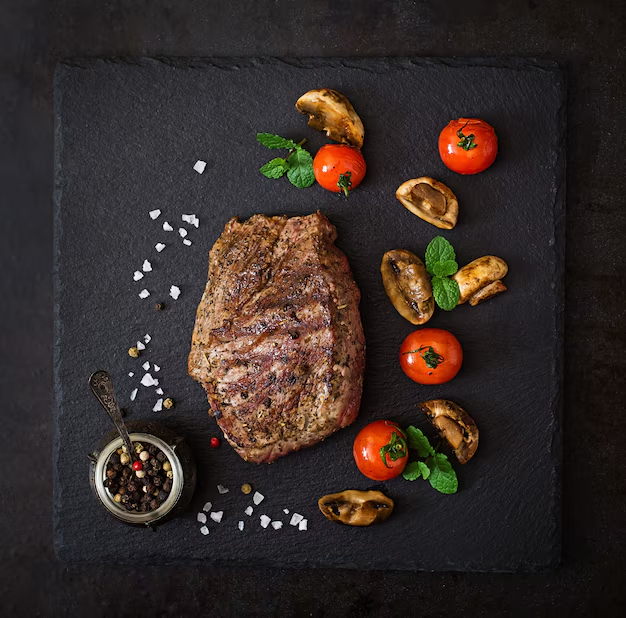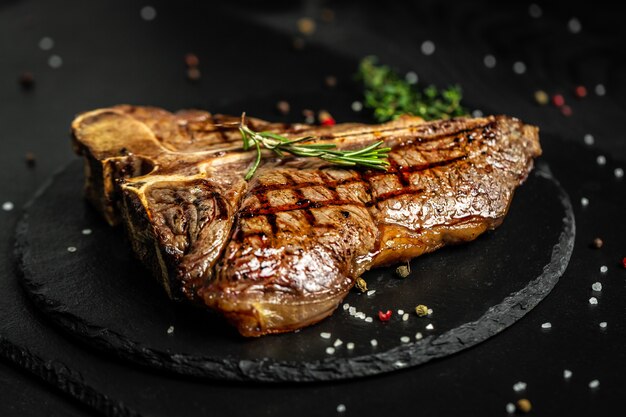Steak is one of the most popular protein-rich foods worldwide. Whether you enjoy it grilled, pan-fried, or roasted, steak offers an indulgent and satisfying meal. However, for those tracking their diet or maintaining a healthy lifestyle, understanding its calorie content is essential. Knowing how many calories are in a steak can help you make smarter choices and balance your meals effectively.
From its cut to its cooking method, many factors influence steak’s nutritional profile. This guide will dive into steak nutrition facts, examine different cuts, and provide tips for making healthier steak choices. By the end, you’ll have a clear picture of which options work best for your dietary needs.
How Many Calories Are In A Steak?
The number of calories in a steak can vary depending on the cut and portion size. On average, a 3-ounce serving of lean beef steak, such as sirloin or tenderloin, contains approximately 180 to 250 calories.
Fatty cuts like ribeye or T-bone can have more calories, with a 3-ounce portion providing around 250 to 350 calories or more. Additionally, the way the steak is cooked (grilled, pan-fried, or roasted) and any added oils or sauces can influence the total calorie content.
Factors That Affect the Calorie Count of Steak
The calorie count of a steak is not static. It changes depending on various factors, such as the cut, cooking method, and trimming. Let’s explore these influences in detail.
Type of Cut
Not all steak cuts are created equal. Each cut has its unique balance of fat and protein, which affects the calorie content. For example:
- Ribeye is known for its marbled fat, making it one of the highest-calorie cuts.
- Sirloin, on the other hand, offers a leaner profile with moderate calories.
- Filet mignon is a luxurious yet lower-calorie option due to its low-fat content.
Cooking Method
How you prepare steak can significantly alter its calorie count:
- Grilled steak is often the healthiest because excess fat drips away during cooking.
- Pan-fried steak absorbs additional oil or butter, adding calories.
- Braised steak may retain more fat, especially when cooked in rich sauces.
Trimming and Fat Content
Removing visible fat before cooking reduces calories significantly. A well-trimmed steak contains less fat and fewer calories than one cooked with all its trimmings. Choosing leaner cuts also supports a lower-calorie meal while still providing plenty of protein.
Calories in Different Types of Steak
Every steak cut offers a distinct calorie profile. Below, we examine the calorie count for popular types of steak to help you make informed choices.
Ribeye Steak
Ribeye is prized for its rich marbling and bold flavor. However, this marbling translates to a higher fat and calorie content.
- Calories per 3-ounce serving: ~240-300 calories.
- Ribeye is ideal for those looking for a decadent treat but may not be the best choice for calorie-conscious eaters.
Sirloin Steak
Sirloin is a versatile cut, striking a balance between flavor and calorie control.
- Calories per 3-ounce serving: ~180-210 calories.
- It’s a leaner option compared to ribeye and works well for grilling or pan-frying.
Filet Mignon
Filet mignon is known for its tenderness and mild flavor. It’s also one of the leanest steak cuts available.
- Calories per 3-ounce serving: ~150-180 calories.
- If you’re looking for a low-calorie yet indulgent choice, filet mignon is a great option.
T-Bone Steak
The T-bone combines the tenderness of filet mignon and the boldness of strip steak.
- Calories per 3-ounce serving: ~220-270 calories.
- Its calorie content varies depending on the ratio of tenderloin to strip steak in the cut.
Flank and Skirt Steak
Flank and skirt steaks are long, flat cuts with a robust beefy flavor. They are leaner than most and perfect for low-calorie meals.
- Calories per 3-ounce serving: ~160-200 calories.
- These cuts are great for tacos, stir-fries, or as a standalone steak dish.
Steak Calorie Chart
Here’s a handy summary of the average calorie content per 3-ounce (85-gram) serving:
| Cut | Calories | Fat (grams) |
| Ribeye | 240-300 | 18-22 |
| Sirloin | 180-210 | 10-12 |
| Filet Mignon | 150-180 | 6-9 |
| T-Bone | 220-270 | 16-20 |
| Flank/Skirt | 160-200 | 7-10 |
How Do Cooking Methods Impact Calorie Counts?
Cooking plays a crucial role in determining the calorie content of a steak. The method you choose can either increase or reduce its overall calories.

Grilling
Grilling is one of the healthiest cooking methods for steak. The intense heat melts away much of the fat, leaving a flavorful yet lean final product.
- Grilled steak typically contains fewer calories than fried or braised options.
- It’s also a great way to avoid adding extra oil or butter.
Pan-Frying
Pan-frying steak adds richness but can also increase the calorie count. Oils, butter, or cooking sprays often contribute significant calories.
- Using healthier oils like olive or avocado oil can reduce this impact.
- Alternatively, non-stick pans can help minimize the need for additional fats.
Slow Cooking and Braising
These methods enhance tenderness, especially for tougher cuts. However, the fat may remain in the dish, increasing calorie density.
- Adding vegetables or low-calorie broths can help balance the meal.
- Avoid heavy creams or sugary sauces for a healthier preparation.
To Read: Minute Steaks In Crock Pot Recipe
Comparing Lean and Fatty Cuts
Not all steak cuts are equal when it comes to calorie content. Understanding the difference between lean and fatty cuts can help you make better dietary choices.
Lean Steak Options
Lean cuts like tenderloin and sirloin are excellent choices for those watching their calorie intake.
- Tenderloin (also known as filet mignon) is one of the leanest options, with ~150-180 calories per 3-ounce serving.
- Top sirloin offers a great balance of flavor and low fat, with ~180-210 calories per serving.
These cuts are perfect for maintaining protein levels while keeping fat content low.
Fatty Steak Cuts
Fatty cuts like ribeye and T-bone, while rich in flavor, have higher calorie counts due to their marbled fat content.
- Ribeye contains ~240-300 calories per 3-ounce serving, thanks to its significant marbling.
- T-bone, combining tenderloin and strip steak, has ~220-270 calories per serving, depending on its fat composition.
Opting for fatty cuts occasionally is fine but may not suit calorie-conscious diets.
Steak and Weight Management
Steak can fit well into a balanced diet, even if you’re trying to lose weight. It’s about choosing wisely and moderating portions.
Low-Carb and Keto-Friendly Nature of Steak
Steak is naturally low in carbohydrates, making it a favorite for low-carb and ketogenic diets. Its high-fat cuts provide energy, while lean cuts are great for protein-focused meals.
Tips for Reducing Calories in Steak
- Portion Control: Stick to a 3-4 ounce serving size to manage calorie intake.
- Trim Visible Fat: Removing fat before cooking reduces calories without sacrificing protein.
- Cooking Methods: Grill or bake instead of frying to keep added fats minimal.
Balancing steak with vegetables or a healthy side ensures a nutrient-packed, calorie-conscious meal.
Nutritional Value Beyond Calories
Steak isn’t just about calories; it’s packed with essential nutrients that benefit your overall health.

Protein Content in Steak
Steak is a protein powerhouse, with ~25-30 grams per 3-ounce serving.
- Protein helps with muscle repair, tissue building, and maintaining satiety.
- It’s a critical nutrient for athletes, growing children, and adults maintaining muscle mass.
Vitamins and Minerals in Steak
Steak provides essential vitamins and minerals, including:
- Iron: Boosts red blood cell production and prevents anemia.
- Zinc: Supports immunity and wound healing.
- B Vitamins: Aid in energy production and brain health.
These nutritional benefits make steak a valuable addition to a well-rounded diet.
Steak Alternatives and Their Calorie Counts
If you’re looking to diversify your protein sources, there are plenty of alternatives to steak. Here’s a brief comparison:
| Protein Source | Calories (per 3 oz) | Protein (grams) | Fat (grams) |
| Chicken Breast | 120-140 | 26-28 | 2-3 |
| Salmon | 170-200 | 20-22 | 9-12 |
| Pork Tenderloin | 120-140 | 23-25 | 3-4 |
Best Cuts for Calorie Management
For those seeking variety, consider these options:
- Chicken breast is lean, high in protein, and lower in calories than most steaks.
- Pork tenderloin offers similar nutritional benefits as sirloin but with a different flavor profile.
- Salmon is a heart-healthy option with beneficial omega-3 fatty acids, though slightly higher in calories.
Choosing alternative proteins helps you explore new flavors while staying calorie-conscious.
To Read: Round Bottom Steak Recipe
FAQs
What are the healthiest steak cuts?
Tenderloin and sirloin are among the healthiest options. They are low in fat, high in protein, and perfect for calorie-conscious eaters.
Does steak work for weight loss?
Yes, when eaten in moderation. Choose lean cuts, control portions, and pair steak with vegetables to create a balanced meal.
What is the protein content of steak?
A 3-ounce serving of steak contains ~25-30 grams of protein, making it an excellent source for muscle repair and growth.
How does cooking impact steak calories?
Grilling reduces fat and keeps calories low, while frying or braising can increase calorie content due to added oils or sauces.
What are good steak alternatives?
Chicken breast, pork tenderloin, and salmon are great alternatives. They provide high protein with fewer calories and different nutritional profiles.
Conclusion
Steak is a delicious and nutritious addition to any meal plan. Whether you prefer lean cuts like sirloin and tenderloin or indulge in marbled cuts like ribeye, understanding how many calories are in a steak is key to making informed choices.
Balance is essential. Opt for portion control, healthy cooking methods, and complement your steak with nutrient-dense sides. By doing so, you can enjoy steak while maintaining your health goals. Choose your cuts wisely, savor the flavors, and let steak be a part of your balanced lifestyle.

